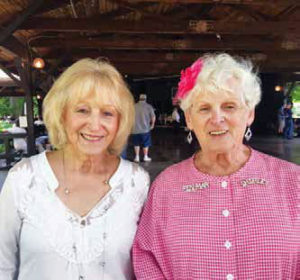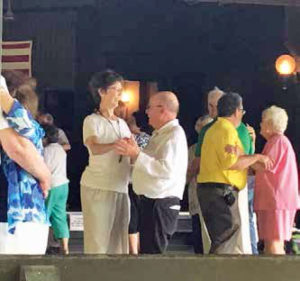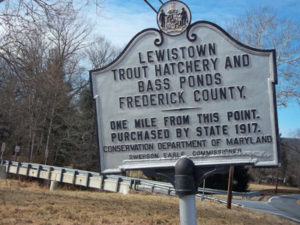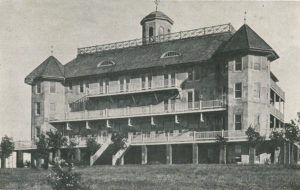Celebrating Its 100th Anniversary
Joan Bittner Fry
Statement Concerning the Monterey Library: From private undated papers. Previous to a library being housed at the Episcopal Church property, a library was located at Dunbrack Inn. The Dunbrack Library was originated by the leaders of the summer community around Monterey and Blue Ridge Summit in 1894. Located behind the library was the Dunbrack Inn. This and other Dunbrack properties were set back almost in the forest along Charmian Road.
The library building and the lot on which it stood belonged to a corporation chartered by the State of Pennsylvania, called the Monterey Library Building Company. This property was originally subject to a mortgage held by a Mrs. Cropper of Washington, D.C., and the mortgage money went into the construction of the library building. This mortgage was finally reduced to $1,800. Mrs. Moore, who at that time owned Mr. Knapp’s cottage; Mrs. Cowman of the Clermont Hotel; Miss Rolando; James Carey; and Thomas Hughes contributed $300 toward the mortgage.
The contents of the library consisted of donations made to The Monterey Improvement Association, which existed for many years from the time of the construction of the library.
There was a similar association at Blue Ridge Summit, called “The Blue Ridge and Monterey Improvement Association.” It was found that The Blue Ridge and Monterey Protective Association was ample to look after the interest of both sections in consequence of the extensive area growth.
The contents of the library, composed of donations exclusively or purchases made with library funds, belong to this community and are supervised and guarded by the committee of the library, the successors of the committee of the former Monterey Improvement Association, and is this for the benefit of the community.
The Monterey Library was reorganized in 1922, and for the next 26 years, was located in the upstairs of the parish house of the Episcopal Church of the Transfiguration (see photo right), near the Western Maryland Railroad Station in Blue Ridge Summit. Miss Elizabeth Willard was the librarian at that time.
The Church of the Transfiguration began as a house church in the late 1800s when summer visitors to Blue Ridge Summit felt a need for worship in the Episcopal tradition. The church grew, and a parish house was built that became the center of much activity in the Blue Ridge Summit area. It eventually housed a library, a basketball court, a bowling alley, a large kitchen for suppers, a stage for plays, and an apartment for the rector. Later, with the advent of air conditioning and each family owning an automobile, the summer population dwindled, and in the early 1960s, the parish house was converted into the present church building. The library was moved to the upstairs of the church.
Western Maryland Railroad Company Donates Blue Ridge Summit Train Station, 1957
Located in the scenic Blue Ridge Mountains, the Blue Ridge Summit Railway Station was deeded July 8, 1957, to the community by the Western Maryland Railroad Company to be used as a public library. The building was a former passenger station for the many thousands of vacationers who came to this resort for the summer. A unique feature of this library is that it serves residents from four counties (Franklin and Adams and Washington and Frederick) and two states (Pennsylvania and Maryland).
The rambling gray railroad station, which dominates this verdantly cool Franklin County town of Blue Ridge Summit, Pennsylvania, in Franklin County, in the center of one of the east’s most famous summer resorts a half century ago, was presented to the people of the community by the Western Maryland Railway Company. The site includes the large frame building, plus 1.5 acres of land.
The wooden building, with its conical metal-covered tower that has been a landmark here for years, wooden platforms, benches, tiny telegraph room and concourse, occupying in all an acre and a half of land, will be used as a public library.
Presentation of the deed for the property marked a brief afternoon ceremony. J. B. Ferguson, a member of the board of directors of the Western Maryland Railroad and a long-time cultural and business leader of Hagerstown, C. R. Zarfoss, vice president of traffic for the Western Maryland Railroad, and a group of town leaders participated.
Mrs. Robert W. Hearne, president of the board of the Blue Ridge Summit Free Library, accepted the deed on behalf of the library and the people of this area. She declared: “The entire community owes a debt of gratitude to the Western Maryland Railway Company for the gift of this station. It is to be a real community center. It is to be preserved, insofar as possible, in its present form. We shall have to change the interior, of course, but we want to retain its outer physical characteristics so that people will always know that it was once a railroad station. We of the board want especially to thank Mr. Ferguson for his efforts on our behalf. When the idea was broached of making this building a library, Mr. Ferguson went to work to help make this dream a possibility.”
Mr. Ferguson then paid tribute to Mrs. Hearne and the library board, Harvey Gearhart, vice president; Miss Marea Harris, treasurer, and Earl Bohn, Miss Blanche Eyler, Mrs. James Annis, Mrs. Jack Kramer, Miss Ethel Wedge, and Miss Martha Connor.
The gay days of the swift Blue Mountain Express that carried Baltimore’s top society the 70 miles to this great mountaintop resort at the turn of the century were recalled nostalgically by those present.
Mr. Zarfoss noted that the train used to carry as many as 2 million riders a year—most of them between Baltimore and the Pen Mar area. In the 1920s, the automobile sounded the death knell of the railroad’s thriving passenger trade and signaled the end of the area’s role as a great summer resort. Mr. Zarfoss presented the library two copies of Harold A. Williams’ The Western Maryland Story.
Miss E. Willard, Summit Librarian, Honored at Dinner
Note: Miss Elizabeth (Betty) Willard was the former librarian. This undated article pertains to her retirement.
In October, Miss Elizabeth Willard, for 35 years the librarian at the Blue Ridge Summit Free Library, has stepped down. Mrs. Robert Hearne, president of the library board, said Mrs. James Annis will take over as librarian. Miss Willard will continue as assistant librarian.
The announcements were made at a dinner meeting at Greystone Inn. The affair honored Miss Willard. Edward Cooey spoke for the group in appreciation of Miss Willard’s service. In addition to Miss Willard, Mrs. Hearne, and Mrs. Annis, the party included J. Harvey Gearhart, vice president; Mrs. Joseph Dailey, secretary; Miss Marea Harris, treasurer; and E. E. Bohn; Miss Blanche Eyler; Mrs. Jack Kramer; Mrs. J. M. Dutrow; and Miss Ethel Wedge. Representing the Washington County Library Association were Edward W. Cooey, president, Mrs. Mary Louise Holzaphel, and Mrs. Madeline S. Startzman.
Western Maryland Railway Station at Blue Ridge Summit became the Blue Ridge Summit Free Library (1957).



 Little remains today that would suggest the size of the hatchery operation that once existed until the early 1950s. A sign on Fish Hatchery Road, off U.S. 15 south, states: “Lewistown Trout Hatchery and Bass Ponds Frederick County – Purchased by State 1917” (shown right).
Little remains today that would suggest the size of the hatchery operation that once existed until the early 1950s. A sign on Fish Hatchery Road, off U.S. 15 south, states: “Lewistown Trout Hatchery and Bass Ponds Frederick County – Purchased by State 1917” (shown right).
